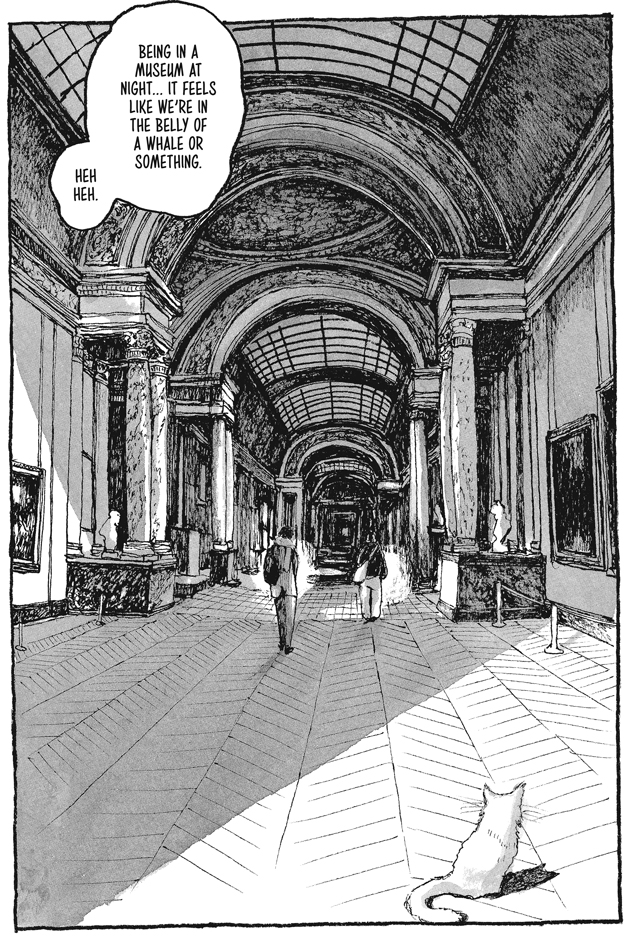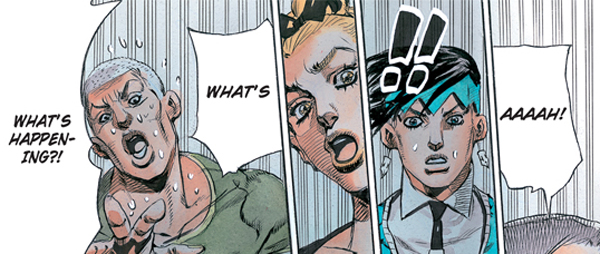Weird. Uncanny. Melancholy. Beautiful. Those were just a few of the adjectives I jotted down while reading Taiyo Matsumoto’s Cats of the Louvre, the latest volume in the museum’s ongoing graphic novel series. Like Nicholas De Crécy’s Glacial Period and Jiro Taniguchi’s Guardians of the Louvre, Cats of the Louvre is less an illustrated guide to the museum than a story that happens to take place within its walls—in this case, the attic, where a colony of cats have taken up residence. Through a series of eighteen vignettes, Matsumoto gradually reveals that the cats’ primary caretaker—an elderly night watchman—has dedicated his life to searching the museum for his missing sister, who disappeared into one of the paintings when she was a child.
The key to finding Arrieta turns out to be Snowbébé, a kitten who frequently escapes from the attic to roam the galleries, hiding inside canvases to avoid detection. Snowbébé’s gift is both an essential plot point and an opportunity for Matsumoto to luxuriate in the smaller details of his favorite paintings, as is evident in a lovely, strange sequence that unfolds inside Henri Lerambert’s The Funeral Procession of Love (1580). From a modern viewer’s standpoint, Lerambert’s painting seems a little kitschy, with its parade of cherubs, poets, and philosophers strolling under the watchful eye of the goddess Diana:
Once Snowbébé steps into the painting, however, the landscape comes to life in unexpected ways: the flowers grin, the animals speak, and the laws of gravity disappear. In one brief but delightful sequence, for example, Snowbébé and Arrieta cavort across the ceilings and walls of a temple, while in another they board Diana’s chariot for a ride through the Milky Way. Yet for all the joyful (and weird) imagery, there’s a wistful quality to these two chapters, as Snowbébé slowly realizes that he cannot remain inside the Parade forever; his presence has disturbed the painting’s equilibrium, bringing storm clouds and disrupting the flow of time itself, forcing him to choose between staying with his new friend, or returning to the “cold and smelly and noisy” world of the Louvre.
 What prevents Snowbébé’s odyssey from seeming twee or precious is Matsumoto’s studied primitivism; his characters’ mask-like faces, oddly proportioned bodies, and grotesque smiles are genuinely unnerving, creating a surreal atmosphere in which the boundaries between reality and imagination are blurred. Nowhere is this tendency more obvious than in the way he draws Snowbébé and his friends: the cats look like animals to their caretakers, but assume a humanoid form when interacting with each other. In Matsumoto’s hands, they look more like people in cat costumes than pussycats, with their essential feline features—ears, whiskers, tails, elongated limbs—rendered in an exaggerated fashion that gives them a faintly alien appearance.
What prevents Snowbébé’s odyssey from seeming twee or precious is Matsumoto’s studied primitivism; his characters’ mask-like faces, oddly proportioned bodies, and grotesque smiles are genuinely unnerving, creating a surreal atmosphere in which the boundaries between reality and imagination are blurred. Nowhere is this tendency more obvious than in the way he draws Snowbébé and his friends: the cats look like animals to their caretakers, but assume a humanoid form when interacting with each other. In Matsumoto’s hands, they look more like people in cat costumes than pussycats, with their essential feline features—ears, whiskers, tails, elongated limbs—rendered in an exaggerated fashion that gives them a faintly alien appearance.
Matsumoto’s depiction of the Louvre is more straightforward, recreating iconic works with fidelity to the originals, whether he’s drawing a lesser-known genre painting or a genuinely famous sculpture. His rendition of the physical environment—the claustrophobic, dusty garret where the cats live, the grand staircases and hallways that lead to the galleries—is similarly precise, helping the reader envision the sheer size and opulence of the museum. As a result, the Louvre transcends its basic function as a setting, taking on the qualities of a living, breathing organism whose vaulted ceilings and majestic columns invite comparisons with dinosaurs or whales:
And while all the comics in the Louvre Collection have done an admirable job of depicting the museum, Cats of the Louvre approaches its subject matter without didacticism or pedantry; though Matsumoto’s human characters express strong feelings about art, those conversations spring organically from the story. Equally important, Cats of the Louvre has its own personality; unlike Hirohiko Araki’s Rohan at the Louvre, which recycled ideas and characters from JoJo’s Bizarre Adventure, Matsumoto’s story stands on its own, capturing his unique response to the museum and its collection. But the best reason to read Cats of the Louvre is its hero Snowbébé, whose quest to find his place in the world invites us to see the Louvre through fresh eyes, as a place of danger and sadness, but also of wonder, magic, and possibility. Recommended.
A review copy was provided by VIZ Media. To read a short preview, click here.
CATS OF THE LOUVRE • STORY AND ART BY TAIYO MATSUMOTO • TRANSLATED BY MICHAEL ARIAS • RATING: TEEN • 432 pp.






